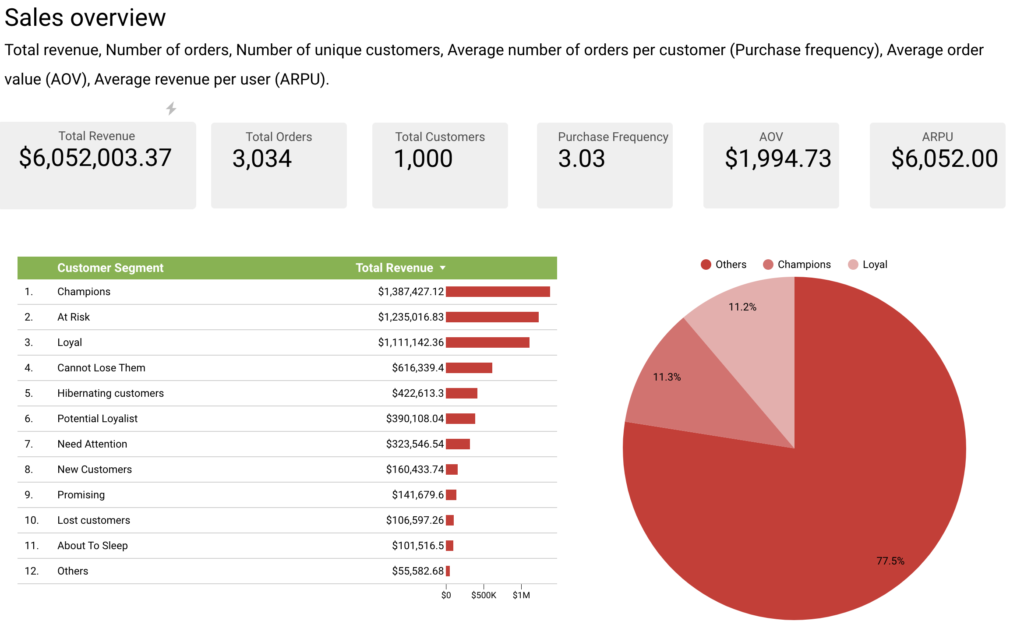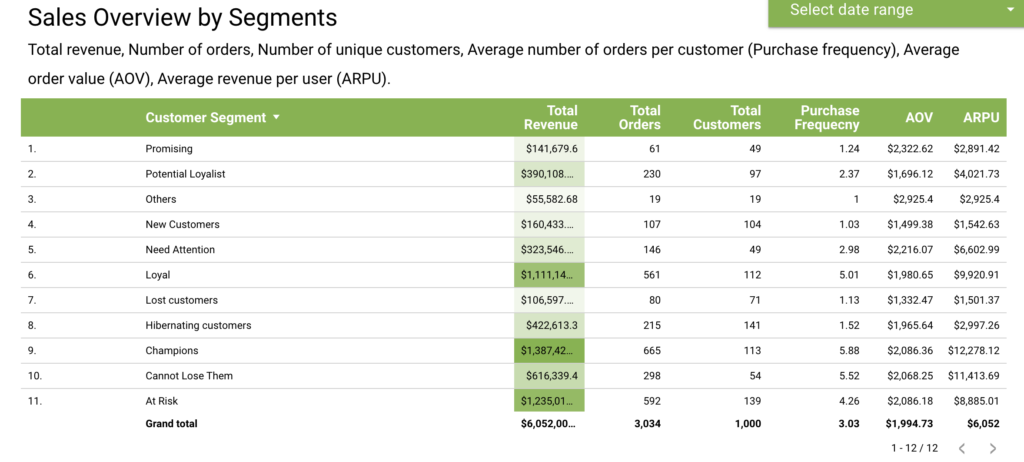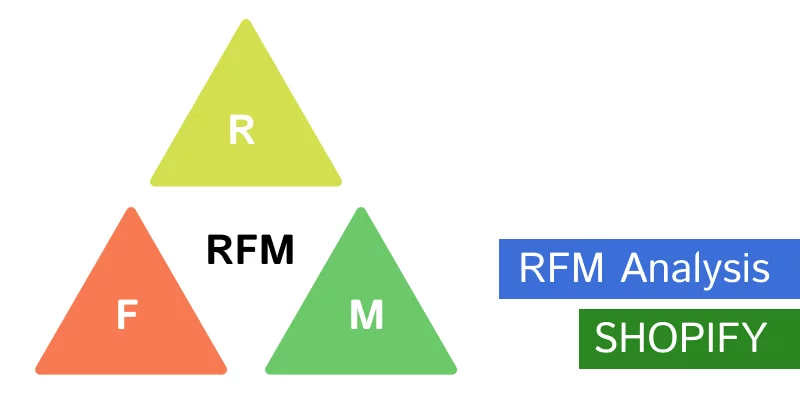The RFM segmentation analysis has proven to be one of the most challenging marketing techniques. As a retailer or a marketer managing a Shopify store, you can use it to gain actionable insights into future customer behavior.
You can do that by monitoring the metrics behind the RFM abbreviation, as you can see below. Once you acquire those insights, you can start executing targeted campaigns, focusing on boosting sales, increasing retention, and nurturing customer loyalty.
Today’s article aims to help you optimize marketing efforts for your Shopify store. It will introduce you to two RFM approaches and three methods of execution and break the process down. Let’s start!
What’s an RFM Analysis?
Increasing revenues and nurturing customer relationships starts with understanding your customers. Once you know who the valuable ones are, you can answer some pressing questions:
- Where to focus marketing efforts?
- How to segment customers with a focus on customer lifetime value?
- How to enhance customer retention efforts?
- How to optimize budget investments and increase ROI?
That process starts with understanding what RFM is and how it works:

A. Definition of RFM segmentation
RFM provides you with a data-driven approach to marketing efforts. It evaluates customers’ significance and importance based on three aspects:
- Recency (R) – or how recent is a customer’s latest purchase. People who bought recently are more likely to buy again.
- Frequency (F) – customers who purchase often are undoubtedly engaged and are more likely to return if you encourage repeat-purchase behavior.
- Monetary Value (M) – which shows the bigger spender among your customers.
When you evaluate customers based on these three dimensions, each gets an RFM score. Then, you can create different segments based on the score and the metric that matters most for your Shopify business.
That means that if you want to make relevant Shopify customer segments, you need to answer various questions like:
- Do you care most about big spenders?
- Is it okay if people spend less but buy more often?
- Are you going to try to reactivate colder segments that spent a lot?
All this might seem like a hassle, but it provides a data-driven, highly accurate method of creating valuable customer segments. And that’s just one of the many benefits of the RMF analysis, as we’ll discuss in the next section.
B. Benefits for Shopify store owners
The RFM segmentation framework helps you gain valuable insights into customer behavior. You need those for several reasons:
- Identify the Most Valuable Customers – those who’ve spent the most money, made the most purchases, and recently. Those are the hottest points of your Shopify business; the people who might be interested in cross-selling and upselling offers and most likely to keep purchasing.
- Optimize Pricing – once you acquire and analyze the monetary value of customers’ orders and behavior, you can adapt your pricing to achieve better results.
- Boost Retention & CLV – by focusing your marketing efforts on the right customers and using the right Shopify apps to apply various retention-boosting strategies. Once you identify the most valuable customers through the RFM framework, you can work toward retaining them and increasing their customer lifetime value – another crucial e-commerce metric.
- Improve Inventory Management – Shopify allows you to enter the broad and lucrative dropshipping field. But if you’re working with an inventory and stock, use RFM to turn it faster and make better decisions to help boost profits and reduce overstocking.
To achieve that, it’s time to make your first steps toward applying RFM segmentation for Shopify customers. Here’s how!
Do you like this article?
Join our CX for Retail dedicated newsletter!

Stay connected to what’s really important to optimize your digital revenues.
By clicking the button, you accept our Terms & Conditions. Also you will need to confirm your email address.
How to Make an RFM Report?
Let’s look at the 3 essential stages of making an RFM analysis of your Shopify store and customer base:
1. Data Collection
Export the available data. It’s right there in your Shopify analytics dashboard. Grab the following aspects:
- Customer name;
- Email address;
- Date of most recent purchase;
- Number of orders placed;
- Total spend.
Those are the key attributes you need to assign an RFM score for each customer. The easiest way to do that is by grabbing an Excel sheet with that information. Once you have it, it’s time to filter and analyze the data.
2. Data Analysis
To get the RFM score, you must assign different scores for each dimension – recency, frequency, and monetary value. The easiest way to approach the RFM analysis is by assigning scores of 1 to 5, with 1 being the lowest and 5 being the highest score.
Let’s consider each dimension:
- Recency – filter the table according to the most recent purchases and assign them an appropriate score. How you define recent depends on your business and the goods that you’re selling. For the sake of the example, let’s assign a score of 5 to all customers who purchased in the last 30 days, 4 to all who purchased in the past 31 to 90 days, 3 to every purchase made between the last 91 to 180 days, 2 for purchases made between 181 days and 270 days, and 1 to everyone else (whose last purchase occurred 9 months ago or more).
- Frequency – retailers offering expensive, luxury goods might consider one purchase per three months per customer to be frequent. If you’re selling consumer goods like shampoo and toothpaste, you might take one sale per month per customer to be frequent. Once you define what it means to you, assign scores from 1 (lowest) to 5 (highest) to each after you filter the table according to the number of orders.
- Monetary Value – filter the table according to total spending and assign scores 1 to 5 to each customer to identify the lowest and highest spenders.
Add one more column to your table, concatenate the R, F, and M scores, and get your RFM.

Once you do that, you’ll have a table that looks something like that:
| Customer | R | F | M | RFM Score |
| A | 1 | 3 | 4 | 134 |
| B | 4 | 1 | 3 | 413 |
| C | 5 | 4 | 5 | 545 |
| D | 2 | 2 | 1 | 221 |
| E | 3 | 5 | 2 | 352 |
Another approach, recommended by the Shopify experts themselves, is to sum the three dimensions. And that significantly simplifies the process of deriving segments from the analysis. In that case, the table above would look something like this:
| Customer | R | F | M | RFM Score |
| A | 1 | 3 | 4 | 8 |
| B | 4 | 1 | 3 | 8 |
| C | 5 | 4 | 5 | 14 |
| D | 2 | 2 | 1 | 5 |
| E | 3 | 5 | 2 | 10 |

Shopify experts suggest filtering them by the highest score. That’s how you’ll have your segments.
We’ll see what these segments can be in the next section, so keep reading.
3. Customer Segments Identification
Segments will vary depending on your approach, the apps helping you score customers, and your specific business needs. Apart from low, mid, and high-value segments, you can identify between six and eleven groups, depending on how you approach the RFM framework.
The most common RFM segments for Shopify customers are:
- New Customers – those with a high recency score but low frequency and monetary scores.
- Potentially Loyal Customers – those with a high recency score, average frequency and monetary value.
- Loyal Customers – those that have high frequency, high recency, and high monetary value scores.
- Champions – you can consider those of your loyal customers who’ve spent the most as Champions and even separate them into a dedicated segment if you want to pay special attention to them through loyalty programs, for example.
- About to Sleep – those with a low frequency score but who have purchased recently. They represent the biggest group in any e-commerce site, and you need to keep them active and engaged if you want to nurture them into loyal customers.
- At Risk – those who haven’t purchased in a while and whose frequency and total spending have declined gradually. They used to be loyal but are about to forget about you and need some attention.
- Lost Customers – also known as Sleepers. They have a very low recency score and probably haven’t purchased in a year, which leads to very low frequency and monetary scores. If you want to get those people back on your store, you must reengage them.
If you’re tech-savvy, you can plot the data you gathered and cleared in the previous stages yourself. If statistics isn’t your forte, there are plenty of Shopify apps you can use to get a visual, as you’ll see below.
How to Create RFM Segmentation for Shopify Customers?
RFM segmentation for Shopify customers helps you increase retention and returns, but also with the purely technical aspects of your site. As a result, you can:
- Focus your marketing efforts where it matters and where it will make a difference;
- Determine what strategies can help with boosting ROI and enhancing customer retention efforts;
- Choose the most suitable Shopify apps for functionalities that help you execute those strategies.
Now that you have a pretty good breakdown of how to approach the RFM segmentation for Shopify customers and how to implement the framework, time to choose the method. Remember that such an analysis is suitable for businesses with a history of at least 6 months.
Once that happens, you can calculate RFM by:
Method 1: Shopify Apps
Shopify apps offer different approaches to calculating RFM. Some notable examples of apps that can help you include:
- Vibetrace – complete marketing automation & customer data platform > we have to put this first
- RetentionX – that scores from 1 (highest score) to 4 (lowest score) and generates between 6 and 7 segments for its users.
- Segments App by Tresl – that comes with 30+ pre-built customer segments and helps you carry out an RFM analysis.

- Loyal RFM – Simple and Free app from Digismoothie
- Reveal by Omniconvert – which uses automated segmentation according to RFM to discover the most valuable customers.
- Loyal by Digismoothie – which can help you plot your segments with ease, allows automatic tagging in Shopify, and can create segments by loyalty.

Method 2: Manually in Excel
If you don’t want to connect an app to your Shopify store, the next option is to do it manually in Excel. That’s the process we broke down above.
It requires a clear idea of your goals and what frequency and recency mean to you in the context of the products you’re offering and your business model.
Method 3: Coding & BigQuery
Using BigQuery requires basic coding knowledge and a working experience with databases using SQL. If that means little to nothing to you, our advice is to turn to your in-house programmer.
Since we know most Shopify store owners don’t maintain programming teams, it might be more reasonable to try and run the RFM analysis yourself.
Alternatively, you can find various resources, like the RFM guide provided by Panoply. They have a detailed Shopify Analytics guide for those of you who have a knack for data and coding.
To Recap
Retention, engagement, and efficiency of marketing campaigns – all benefit from RFM segmentation for Shopify customers. The analysis takes three dimensions available in your Shopify analytics and provides a treasure trove of data.
If you want to win more customers and grow your e-commerce business on Shopify, you need data. It helps you focus your marketing campaigns, identify your most valuable customers, and recognize potential.
Using a customer data platform like those featured in apps like VibeTrace can tell you a lot about clients. Using that data to analyze and segment them according to their loyalty and potential can transform businesses.
RFM segmentation for Shopify customers helps you keep your top 20% engaged but most importantly, retain the top 10%. The highest paying, most frequently purchasing champions of your business. Don’t let hesitation stop you from running an RFM analysis and nurturing profitable customer relationships based on loyalty.
Leverage the above breakdown and let data work for you.

